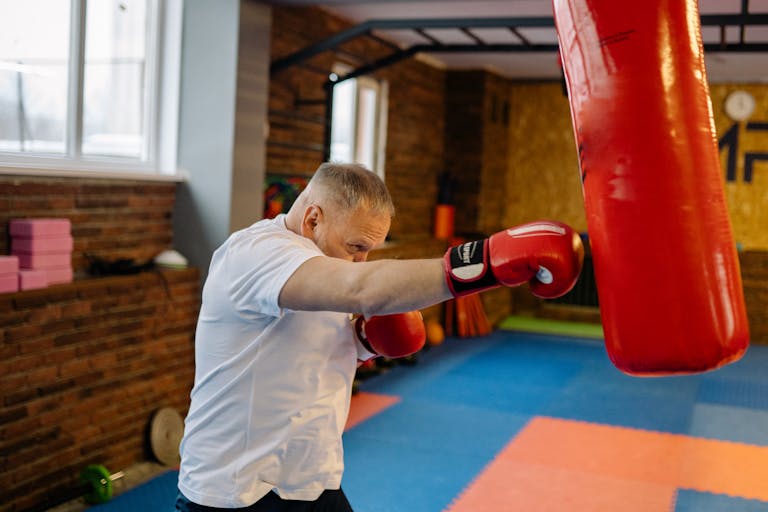FREE SHIPPING OVER $50
Out of Breath on the Stairs? Doctors Say This Is the Real Reason—and How to Fix It Fast

It happens to almost everyone: you take those first few steps, and by the time you reach the landing, you’re leaning over, gulping for air. You might dismiss it as a momentary lapse in fitness or a sign you’re getting older, but that sudden feeling of being out of breath while climbing stairs is actually your body sending a clear, important signal. Climbing stairs is a concentrated, high-intensity activity, and how quickly you recover afterward directly reflects your overall cardiovascular fitness and aerobic capacity.
The truth is, feeling winded isn’t usually caused by weak leg muscles; it’s a sign your heart and lungs—your body’s engine—are struggling to keep up with the sudden demand for oxygen. Doctors and fitness experts agree that the primary culprit is low V̇O₂ max, or poor cardio endurance, stemming from a sedentary lifestyle. Fortunately, this isn’t a permanent condition. We’re going to dive into the specific reasons this happens and, most importantly, provide actionable, fast fixes you can implement today to make those steps feel effortless.
The Real Reason You Get Winded: Low Aerobic Capacity
The central issue behind struggling with stairs is a physiological mismatch: your body cannot deliver oxygen to your working muscles as efficiently as the activity demands. When you quickly ascend a flight of stairs, you engage in a burst of high-intensity effort. This sudden output requires rapid cellular energy, which the body produces most efficiently using oxygen.
The Science Behind the Gasp
The scientific term for the struggle is low V̇O₂ max. V̇O₂ max is the maximum rate of oxygen your body can use during intense exercise. When your aerobic fitness is low, your heart, lungs, and blood vessels aren’t optimized to process and transport oxygen quickly.
Here is what happens in the body when you climb stairs with low V̇O₂ max:
- Heart Overdrive: Your heart has to pump much faster to move oxygenated blood to the large muscles in your legs. Because your heart muscle isn’t trained for this, it reaches its maximum output quickly.
- Oxygen Debt: Your leg muscles, demanding immediate energy, are forced to switch to anaerobic metabolism (producing energy without oxygen). This is quick, but it generates lactic acid rapidly, causing that burning sensation and the overwhelming need to stop.
- The Breathless Signal: Your brain senses the buildup of carbon dioxide (a byproduct of metabolism) and the lack of oxygen, triggering a frantic, reflexive need to hyperventilate. This results in the “out of breath” feeling you experience at the top of the stairs.
Essentially, the more sedentary you are, the lower your V̇O₂ max remains, making everyday activities like stair climbing feel like a marathon. We can fix this by specifically targeting and improving your cardio endurance.
The Fast Fix: Training the Engine, Not the Legs
To fix the breathlessness problem, you must shift your focus from training the muscles that move you (your legs) to training the organs that power you (your heart and lungs). Doctors and trainers recommend incorporating short, sharp bursts of cardio training to increase your V̇O₂ max quickly.
1. The Power of High-Intensity Interval Training (HIIT)
Nothing improves cardiovascular fitness faster than HIIT. This training style involves short periods of intense effort followed by brief recovery periods. This method specifically trains your heart to pump more blood per beat and forces your body to become more efficient at utilizing oxygen.
- The Fix: Start with 15 minutes, three times a week. Try 30 seconds of all-out effort (like sprinting, fast jump roping, or even running in place) followed by 60 seconds of gentle recovery. Repeat for 15 rounds. The stair struggle will start to disappear within weeks.
2. Practice Using the Stairs as Training
The best way to get better at an activity is to do it. You don’t have to tackle the whole skyscraper, but you should intentionally integrate stair climbing into your daily routine as a mini-workout.
- The Fix: Perform a simple stair workout two or three times a day. Walk up one flight, come down, and repeat four times. Focus on controlling your breath: inhale deeply for two steps, exhale for two steps. This practice trains your body to manage the workload in the specific scenario where you need efficiency.
3. Deep Breathing and Diaphragmatic Training
Often, we only use the upper part of our lungs when we breathe, which limits the amount of oxygen we can take in. Training your diaphragm—the primary muscle of respiration—can drastically improve the efficiency of your lungs.
- The Fix: Practice diaphragmatic breathing for five minutes every morning. Lie down, place one hand on your chest and the other on your stomach. Inhale deeply through your nose, expanding your stomach (not your chest) like a balloon. Exhale slowly through pursed lips. Stronger respiratory muscles mean less fatigue when you need them most.
Underlying Health Considerations to Note
While low fitness is the most common reason for breathlessness, doctors caution that persistent, severe, or worsening shortness of breath can signal a more serious underlying issue. If the stair struggle is accompanied by chest pain, dizziness, or is getting worse over time despite increased activity, you should consult your doctor immediately.
Anemia and Heart Health
Two key health conditions can directly impair your body’s oxygen delivery system:
- Anemia (Low Iron): Iron is essential for creating hemoglobin, the protein in red blood cells that carries oxygen. If you have low iron, your blood simply cannot transport enough oxygen, no matter how hard your lungs work. A simple blood test can diagnose this.
- Heart Dysfunction: Conditions like congestive heart failure or coronary artery disease can severely limit the heart’s ability to pump blood effectively. This quickly leads to breathlessness under exertion.
It’s crucial to rule out these medical factors before fully committing to a fitness-only fix, especially if you have a history of heart issues or if the breathlessness comes on suddenly.
Long-Term Strategy: Building True Endurance
To permanently fix the “out of breath” feeling, you need to transition the temporary fixes into a sustainable, consistent fitness routine. This requires building your aerobic endurance gradually over time.
The “Zone 2” Principle
Many fitness experts suggest incorporating Zone 2 cardio for 30 to 60 minutes multiple times per week. Zone 2 refers to exercise intensity where you can still carry on a broken conversation—you’re working hard, but not all-out.
- Examples: Brisk walking, light jogging, cycling, or using an elliptical machine.
- Why It Works: Training in this steady state burns fat efficiently and, more importantly, trains your mitochondria (the powerhouses of your cells) to utilize oxygen far more effectively. This is the cornerstone of great cardio health.
Conclusion
When starting out, consistency is more important than intensity. A daily 20-minute brisk walk is infinitely more effective for improving stair climbing ability than one punishing hour-long sprint session a week. Building true stamina requires your cardiovascular system to adapt gradually. Make movement a non-negotiable part of your day, even on rest days.
By targeting your cardio endurance with smart training, practicing proper breathing, and staying consistent, you will transform the dreaded stair climb into a simple, effortless task. You don’t just gain the ability to climb stairs without gasping; you gain significant heart health benefits and drastically improve your quality of life.
Related Articles
- Doctors Say These 4 Daily Moves Reverse Muscle Loss Faster Than the Gym—No Equipment Needed
- Doctors Are Stunned: These 15 Mobility Tricks Have Seniors Moving Like They’re 30 Again
- 10 Exercises That Could Be Dangerous After 60—Most People Still Do #7
- Can’t Sit Cross-Legged? Try These Trainer-Approved Standing Hip Stretches
- Transform Your Body After 50: Top Exercise Habits Revealed



